Citizen Scientists on the Great Barrier Reef - do they make a difference?

It’s hard not to feel despondent about the health of the oceans, especially in the wake of recent news that coral is having its worst decline on record https://www.bbc.com/news/articles/cvg3pp52m65o.amp. But many people are working hard for its future, among them the ‘citizen scientists’ on the Great Barrier Reef and the sole not-for-profit organisation in the area, is urging more to get involved. The Oceans2Earth project trains a new batch volunteers every month to snorkel for 1–3 weeks with underwater notebooks to observe and collect scientific data on coral, turtles and other marine life. Volunteers carry out around 8000 hours of work a year.
The founders claim they've quietly been trying to reframe volunteer travel, changing it from ‘voluntourism’ to impactful and sustainable research. The tiny 10 year old operation, overshadowed by big bucks tourism firms, works an unusually non-invasive way in order to be ‘100% ethical and impactful’. Part of their modus operandi is not to touch any marine life, including coral, which can die on contact.
Data is collected all year round on coral health and marine life and fed back to universities and government to inform decisions about conservation. Volunteers film turtles nibbling on the reef, spot giant clams, rays or shivers of reef sharks in the shallows of the islands off Cairns.
O2E use 4 types of in-water surveys. For Coral Watch, they record the health of soft, branching, plate and boulder coral by matching it to a colour chart — the darker the healthier. The records go into an infinite opensource database that can be accessed by anybody on the planet, scientist or not. In one year around 400 surveys are carried out.
The Rapid Monitoring Eye on the Reef survey is a ten minute biodiversity observation of iconic or endangered species like sea turtles and sharks, conducted alongside a habitat analysis to help understand why they are seeing those animals in that space. It’s sent directly to the GBR Marine Park Authority to inform their decisions about managing the reef, such as designating the protected zones.
In order to monitor the sea turtle population the team use underwater filming instead of metal tagging or other invasive methods, because turtles have a unique facial scale pattern which can be used as a fingerprint to ID them. From 2023–4 there were 157 sightings.
Teams also carry out marine debris analysis through beach clean-ups, breaking down and analysing all the trash which helps the government figure out where it comes from and stop it from reaching the beach in the first place. 300 kg of debris was removed last year.
Team leader Helen Young says, ‘I’m always meeting the best version of the human race when I encounter volunteers, because these people are the ones that actually want to do something good with their time and their life’.
O2E wants more individuals and charities to get involved in the sector.
Volunteers on the August 2025 project described their experience as ‘inspiring’, ‘meaningful’ and ‘life-changing’. The youngest of the group of 12, Brynne O’Hare from Chicago, 18, urges others to participate: ‘Be the person. If not you, then who?’
Helen has seen people think again about their careers and lifestyles as a result of being citizen scientists: ‘I think the most important thing that the reef does, at least to me and to my volunteers is that it inspires people, to change patterns in their life that they haven’t thought to change before’.
About Author: Catherine Adams is a former BBC correspondent, Journalist for over 30 years, currently Senior Lecturer in Communications and Society.
Similar Post You May Like
-

CFCs, HFCs and their long, troubled history
At its peak, the ozone hole covered an area 7 times larger than the size of Europe, around 29.9 million km2, and was rapidly expanding
-

The Origin of Universe: Deciding point where it all began!
Let us unravel and surf through the ideas throughout ages to understand what the universe and its origin itself was to its inhabitants across history.
-

The Artemis Program
Inspired by the Greek goddess of the Moon, twin sister to Apollo, the artimis program was named on 14 May 2019 by Jim Bridenstine.






